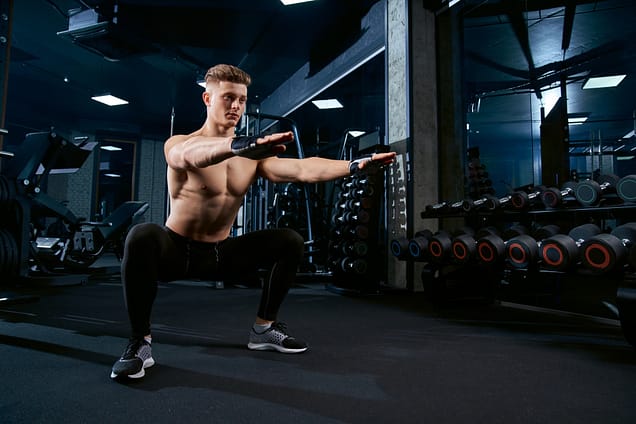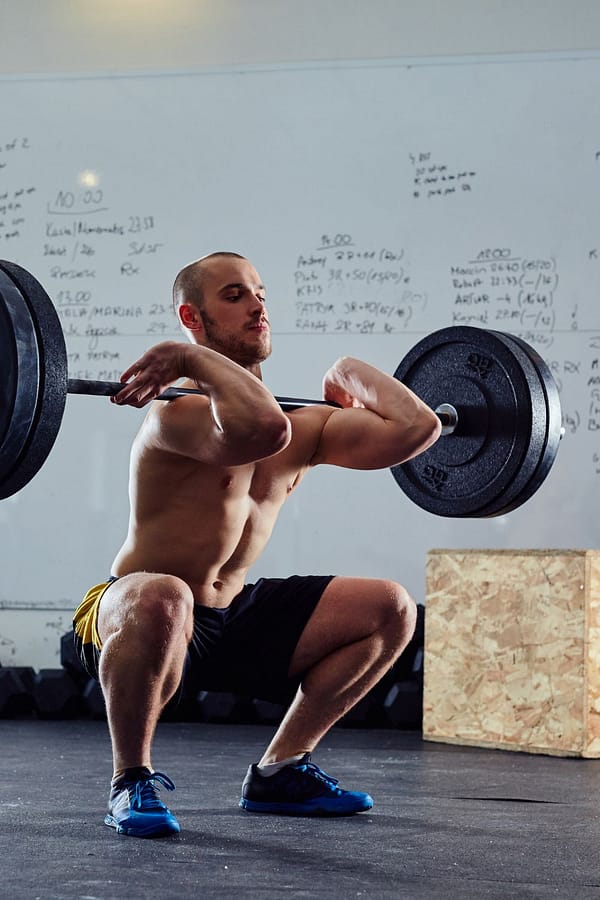Table of Contents
ToggleWhy Squats?
Squats are a powerhouse exercise, engaging multiple muscle groups simultaneously. They aid in developing lower body strength, core stability, and explosiveness, all of which are pivotal in martial arts performance. Here’s a breakdown of the key squat variations that can elevate your martial arts techniques:
1. Bodyweight Squats
Ideal for beginners, bodyweight squats lay the foundation for proper form and technique. They bolster leg strength, improve balance, and focus on mastering the fundamental movement pattern essential in various martial arts stances and maneuvers.

2. Barbell Back Squats
Introducing resistance through a barbell amplifies the challenge, effectively building strength in the quadriceps, hamstrings, glutes, and lower back. The increased load closely mimics the demands of explosive movements like kicks and swift directional changes in martial arts.
3. Front Squats
This variation places the barbell across the front of the shoulders, altering the weight distribution and engaging the core more intensely. Front squats not only strengthen the legs but also enhance posture and stability, vital in executing precise martial arts techniques.

4. Overhead Squats
Advanced practitioners benefit from overhead squats, integrating the lower body strength with upper body stability. This variation demands exceptional flexibility, coordination, and core strength, attributes crucial in executing dynamic martial arts techniques with precision.

The Impact on Martial Arts Techniques
Enhanced Leg Strength: Squats fortify the muscles essential for swift kicks, powerful strikes, and stable stances, allowing martial artists to generate greater force efficiently.
Improved Balance and Stability: The core engagement and lower body strength gained from squats contribute significantly to maintaining equilibrium during complex martial arts movements, reducing the risk of injury.
Increased Explosiveness: The explosive power cultivated through squat variations aids in swift movements, rapid strikes, and sudden directional changes, essential in various martial arts disciplines.
Core Strength and Posture: A strong core and improved posture foster better technique execution and endurance, ensuring martial artists can maintain form and power throughout extended training sessions or competitions.
Integrating Squats into Training
To optimize the benefits of squat exercises for martial arts, consistency and proper form are key. Integrate them into your training routine, gradually increasing intensity and resistance while maintaining correct posture. It’s crucial to consult with a fitness professional or martial arts instructor to tailor squat variations to your specific discipline and level.
So.
In conclusion, incorporating squats into your training routine can significantly enhance your martial arts prowess. These exercises lay a solid foundation of strength, stability, and explosiveness crucial for executing techniques with precision and power. Remember, consistency, proper form, and gradual progression are key elements in reaping the maximum benefits from squat exercises.
Let’s delve deeper into the finer points of how squat exercises specifically benefit various martial arts techniques and how they can be integrated strategically into your training routine.
Squats and Martial Arts Techniques
1. Kicking Techniques
Squats are instrumental in strengthening the muscles involved in executing powerful kicks. The explosive force generated from squat-based exercises enhances the speed and strength of kicks, enabling martial artists to deliver swift and impactful strikes.
2. Stance and Balance
Maintaining a stable and balanced stance is crucial in martial arts. Squats improve lower body strength and stability, translating to enhanced balance during stationary positions and dynamic movements, such as evasive footwork or defensive postures.
3. Agility and Mobility
Squat variations like jumping squats or plyometric squats enhance agility and mobility, facilitating quick transitions between stances and movements in martial arts. These exercises train the muscles to contract rapidly, mimicking the rapid movements required in sparring or combat situations.
4. Core Strength for Technique Precision
The engagement of the core muscles during squats strengthens the torso, contributing to better control and precision in executing techniques. A strong core enables martial artists to maintain proper posture and alignment throughout their movements, optimizing technique execution.
5. Endurance and Conditioning
Squat-based workouts improve overall endurance, allowing practitioners to sustain intense training sessions or prolonged matches without compromising technique quality due to fatigue.
Tailoring Squat Exercises to Your Martial Arts Discipline
Different martial arts disciplines may prioritize specific techniques or movements. Therefore, tailoring squat exercises to complement these techniques is essential:
Karate and Taekwondo: Emphasize explosive movements and high kicks by incorporating plyometric squats and jump squats into your training routine.
Muay Thai and Kickboxing: Focus on building strength in the legs and hips to deliver powerful strikes and kicks. Barbell back squats and front squats can be particularly beneficial.
Brazilian Jiu-Jitsu and Judo: While leg strength remains crucial, these disciplines require a strong core for grappling and ground techniques. Include a mix of front squats and overhead squats to enhance both leg and core strength.
Mixed Martial Arts (MMA): MMA training demands a well-rounded approach. Incorporate a variety of squat exercises to improve overall strength, explosiveness, and agility, essential for the diverse skill set needed in MMA bouts.
External Links for Further Reference:
The Importance of Squats in Martial Arts – Explore how squats specifically benefit martial arts performance.
5 Squat Variations for Martial Artists – Discover additional squat variations targeted towards improving martial arts techniques.
Strength and Conditioning for Martial Arts – Understand the broader importance of strength and conditioning in martial arts practice.
Conclusion
Squat exercises serve as a cornerstone in enhancing martial arts techniques by improving strength, balance, agility, and core stability. Integrating a variety of squat variations into your training routine, tailored to your specific martial arts discipline, can significantly elevate your performance. Remember, consistency and proper form are paramount to reap the full benefits of these exercises.
Feel free to explore the provided external links for a more in-depth understanding of how squats can revolutionize your martial arts training
Comparison tabular
| Squat Variation | Benefits for Martial Arts |
|---|---|
| Bodyweight Squats | – Foundation for proper form and technique |
| – Improved balance and mastering movement patterns | |
| Barbell Back Squats | – Strengthens quadriceps, hamstrings, and glutes |
| – Mimics demands of explosive movements in martial arts | |
| Front Squats | – Engages core intensely, improving stability |
| – Enhances posture for precise technique execution | |
| Overhead Squats | – Integrates lower body strength with upper body stability |
| – Requires exceptional flexibility and core strength |
This table outlines how each squat variation contributes to enhancing specific aspects of martial arts techniques. Bodyweight squats establish a foundation, while barbell back squats emphasize strength-building, front squats focus on core engagement, and overhead squats integrate full-body strength and stability.
These distinctions can guide martial artists in selecting the most suitable squat variations based on their training goals and specific discipline requirements.
Wrapping up
In the realm of martial arts, mastering techniques requires a fusion of discipline, skill, and physical prowess. Squat exercises, in their diverse variations, serve as a pivotal tool to enhance these qualities.
Whether you’re a beginner laying the groundwork with bodyweight squats or an advanced practitioner honing explosiveness with overhead squats, incorporating these exercises can elevate your martial arts journey. Strengthening the legs, engaging the core, and refining balance through squats can directly translate to sharper kicks, more stable stances, and greater agility in combat scenarios.
Remember, the key lies not just in the variety of squats you incorporate but in their consistent practice, aligned with your martial arts discipline’s specific demands. Consult with experts, tailor your routine, and strive for proper form to harness the full potential of squats in refining your martial arts techniques.
As you embark on this journey, integrating squats intelligently into your training regimen can be the secret weapon propelling you toward mastery in your chosen martial arts discipline. Keep squatting, refining, and evolving, and watch as your techniques flourish.

Hey there, it’s Mike Rrsq, the Editor-in-Chief over at Jsquat.com, and I’m absolutely obsessed with all things squat fitness! I’ve been lucky enough to get some serious recognition for my work in this field. With a solid background in the fitness and wellness industry, I’ve been there right from the get-go, helping shape this website into what it is today.
You see, I’m not just the boss around here; I’m also a passionate contributor. I love sharing my insights through my articles, and trust me, they’re not your run-of-the-mill stuff. Each piece I write is a labor of love, filled with my expertise and real-world experience in the fitness universe. So, if you’re into fitness and looking for some inspiration, you’re in the right place!
Related Posts
- The Top 3 Effective Squat Variations for Improved Weightlifting Performance in 28-year-old male
Weightlifting demands a robust foundation, and the right squat variation can be a game-changer for…
- The best 3 most effective squat variations you need for better improved golf swing.
Golf, a game that combines finesse, strength, and precision, demands a lot from your body.…
- Best 3 most effective squat variations you need for targeting the adductor magnus.
Squat is one of the most effective exercises that you can do to target quads…
- The Best 3 Most Effective Squat variations for targeting the obliques.
Squats are renowned for their ability to strengthen and tone the lower body, but did…
- The best 5 most effective squat variations you need for better basketball performance
Basketball demands a unique blend of strength, agility, and explosive power. Choosing the right squat…
- The Top 3 Effective Squat Variations you need for better swimming performance.
Swimming is an intricate sport that demands a blend of strength, endurance, and technique. While…
- The best 4 squat variations for improving balance in 63-year-old adults
As we age, maintaining balance becomes increasingly crucial for overall well-being, reducing the risk of…
- The best 3 most effective squat variations you need for better soccer performance.
Squats are a foundational exercise for athletes across various sports, and for soccer players, they…

